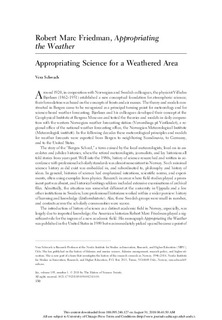| dc.contributor.author | Schwach, Vera | |
| dc.date.accessioned | 2018-10-04T12:14:31Z | |
| dc.date.available | 2018-10-04T12:14:31Z | |
| dc.date.created | 2018-06-22T09:55:03Z | |
| dc.date.issued | 2018 | |
| dc.identifier.citation | Isis. 2018, 109 (1), 130-133. | nb_NO |
| dc.identifier.issn | 0021-1753 | |
| dc.identifier.uri | http://hdl.handle.net/11250/2566464 | |
| dc.description.abstract | Around 1920, in cooperation with Norwegian and Swedish colleagues, the physicist Vilhelm Bjerknes (1862–1951) established a new conceptual foundation for atmospheric science; their formulation was based on the concepts of fronts and air masses. The theory and models constructed in Bergen came to be recognized as a principal turning point for meteorology and for science-based weather forecasting. Bjerknes and his colleagues developed their concept at the Geophysical Institute at Bergens Museum and tested the theories and models in daily cooperation with the western Norwegian weather forecasting station (Vervarslinga på Vestlandet), a regional office of the national weather forecasting office, the Norwegian Meteorological Institute (Meteorologisk institutt). In the following decades these meteorological principles and models for weather forecasts were exported from Bergen to neighboring Scandinavia, to Germany, and to the United States. | nb_NO |
| dc.language.iso | eng | nb_NO |
| dc.title | Second look: Robert Marc Friedman, Appropriating the weather, “Appropriating science for a weathered area” | nb_NO |
| dc.type | Journal article | nb_NO |
| dc.type | Peer reviewed | nb_NO |
| dc.description.version | publishedVersion | nb_NO |
| dc.source.pagenumber | 130-133 | nb_NO |
| dc.source.volume | 109 | nb_NO |
| dc.source.journal | Isis | nb_NO |
| dc.source.issue | 1 | nb_NO |
| dc.identifier.doi | 10.1086/697185 | |
| dc.identifier.cristin | 1593100 | |
| cristin.unitcode | 7463,0,0,0 | |
| cristin.unitname | NIFU Nordisk institutt for studier av innovasjon, forskning og utdanning | |
| cristin.ispublished | true | |
| cristin.fulltext | original | |
| cristin.qualitycode | 2 | |
